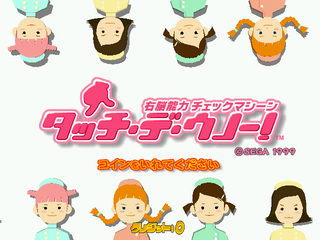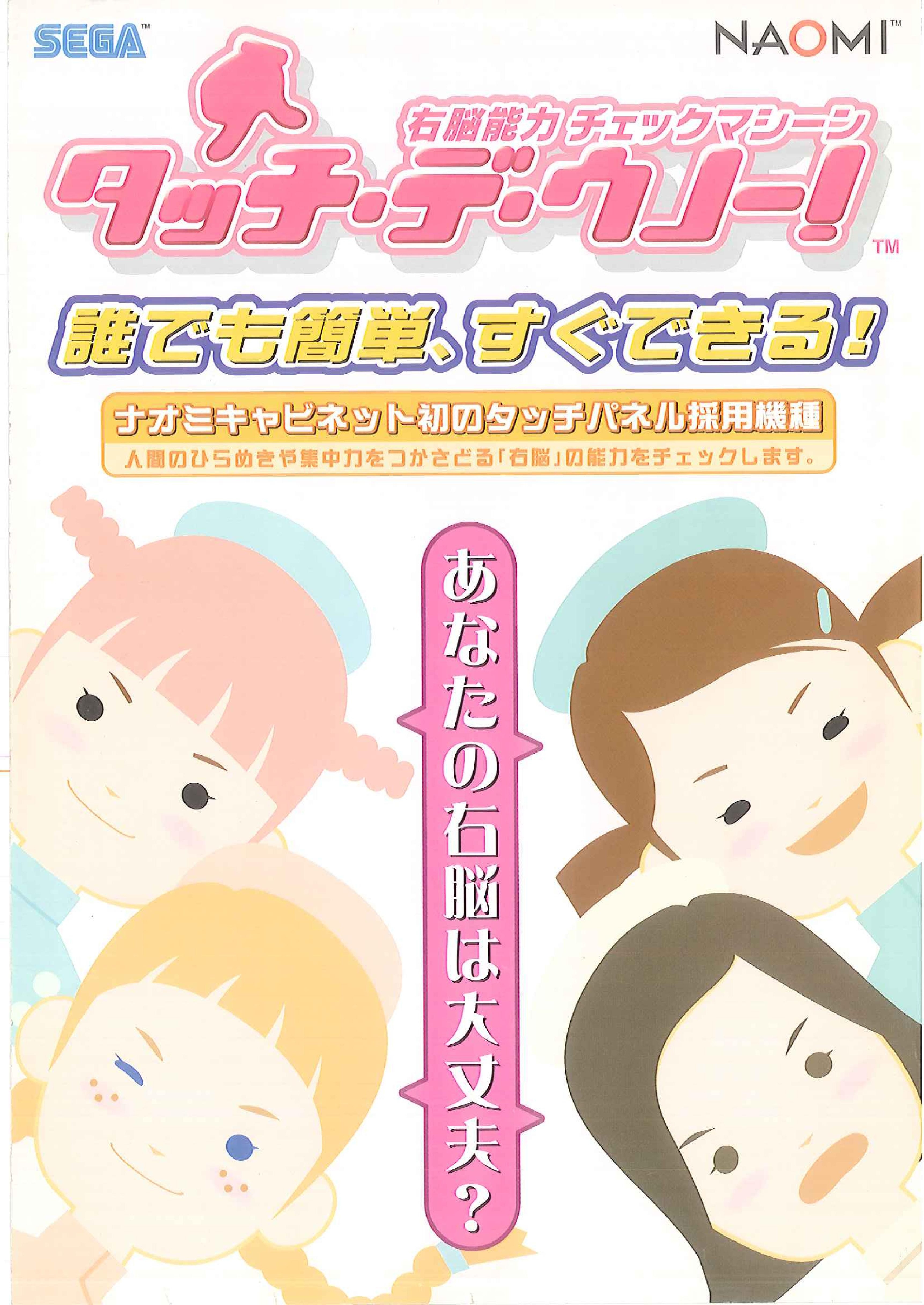Difference between revisions of "Touch de Uno!"
From Sega Retro
| Line 52: | Line 52: | ||
==Production credits== | ==Production credits== | ||
| + | The game contains a lengthy default high score table. The earlier names reference the developers, followed by some references to characters from ''[[Cyber Troopers Virtual-On]]''. | ||
| + | {{multicol| | ||
{{creditstable| | {{creditstable| | ||
| − | *'''Assistant Director:''' [[Shoichiro Kanazawa]] | + | *{{rolloverText|てらだ|Terada}} |
| − | *'''Programmers:''' | + | *{{rolloverText|はるひ|Haruhi}} |
| − | *'''Artists:''' [[Seiichi Yamagata]] | + | *{{rolloverText|やんま|Yanma}} |
| − | *''' | + | *'''Assistant Director:''' [[Shoichiro Kanazawa]]{{ref|http://web.archive.org/web/20021222042301fw_/http://www.hitmaker.co.jp/top/lounge/corumun/site/corumun_txt39.htm}} ({{rolloverText|かなざわ|Kanazawa}}) |
| − | *''' | + | *'''Sound Designer:''' [[Seiichiro Matsumura]] ({{rolloverText|せいちろ|Seiichiro}}) |
| + | *'''Programmers:''' [[Ryuji Ochi]] ({{rolloverText|りゅうじ|Ryuji}}), [[Takeshi Yamazaki]]{{ref|1=https://jglobal.jst.go.jp/detail?JGLOBAL_ID=200903035215663586}} ({{rolloverText|やまざき|Yamazaki}}), [[Bungo Ishida]] ({{rolloverText|ぶんご|Bungo}}), [[Ai Nakamura]]{{magref|dmjp|1999-33|158}} ({{rolloverText|あい|Ai}}) | ||
| + | *'''Artists:''' [[Seiichi Yamagata]]{{ref|1=https://jglobal.jst.go.jp/detail?JGLOBAL_ID=200903035215663586}} ({{rolloverText|がた|Gata}}), [[Naoko Ofuji]] ({{rolloverText|おーじ|O-ji}}), [[Shintaro Ito]] ({{rolloverText|しんたろ|Shintaru}}) | ||
| + | *'''Mechanical Engineer:''' [[Seiji Ishii]] ({{rolloverText|せいじ|Seiji}}) | ||
| + | *'''Electrical Engineer:''' [[Hideyuki Yamada]] ({{rolloverText|びでゆき|Hideyuki}}) | ||
| + | *'''Cabinet Designer:''' [[Kazuhiro Nojo]] ({{rolloverText|のうじょ|Nojo}}) | ||
| + | *{{rolloverText|てむじん|Temjin}} | ||
| + | *{{rolloverText|らいでん|Raiden}} | ||
| + | *{{rolloverText|ふぇい|Fei}} | ||
| + | *ぐりす | ||
| + | *あふぁぴ | ||
| + | *あふぁえ | ||
| + | *さいふあ | ||
| + | *ばる | ||
| + | *すぺ | ||
| + | *どるどれ | ||
| + | *えんじぇ | ||
| + | *あじむ | ||
| + | *ぶらっと | ||
| + | *たんぐら | ||
| console=NAOMI | | console=NAOMI | ||
| − | | source= | + | | source=In-game high score table |
| + | }} | ||
| + | {{hr}} | ||
| + | {{creditstable| | ||
| + | *'''Support:''' [[Chiho Kobayashi]]{{ref|https://web.archive.org/web/20011124173331fw_/http://www.hitmaker.co.jp/game/SOUND/SITE/MEMBER05.html}} | ||
| + | | console=NAOMI | ||
| + | | source=Developer mentions | ||
| + | }} | ||
}} | }} | ||
Revision as of 16:09, 15 April 2024
| Touch de Uno! | |||||||||
|---|---|---|---|---|---|---|---|---|---|
| System(s): Sega NAOMI | |||||||||
| Publisher: Sega | |||||||||
| Developer: Sega Software R&D Dept. 3[1] | |||||||||
| Genre: Puzzle | |||||||||
| Number of players: 1[2] | |||||||||
|
This teeny-tiny article needs some work. You can help us by expanding it.
Touch de Uno! (タッチ・デ・ウノー!) is a puzzle game developed and published by Sega for the Sega NAOMI arcade platform. The name derives from its touch-screen controls and from Uno (右脳), meaning the right side of the brain, which its minigames are meant to target. When playing the Check Course mode, a Check Sheet is printed out at the end showing the player's results.
Contents
Gameplay
Touch the Uno! is played by touching the arcade's screen.
Minigames
| Mojimoji Sagashi (モジモジさがし) | |
|---|---|
| A collection of panels are given to the player, each with a different kanji character on them. The player must tap the pair of identical characters. Contains 5 levels per stage across 6 stages. Localized as Character Hunt in Brain Assist. | |
| Rokkaku Paint (ろっかくぺイント) | |
| On a hexagonal grid, there will briefly be shown some colored panels. A smaller grid with 4 colors will then be shown where the player must tap on the colors that were shown before. Contains 4 levels per stage across 6 stages. Localized as Hexagonal Colors in Brain Assist. | |
| Parapara Kioku (パラパラきおく) | |
| A series of shapes are briefly shown one at a time, after which there will several collections of shapes. The player must select the one with the correct combination of shapes. Contains 3 levels per stage across 7 stages. Localized as Scattered Memory in Brain Assist. | |
| Count-Mania (カウントマニア) | |
| The player must tap the numbers in ascending order, made more difficult as the visual size of the numbers are not consistent with the sequence. Contains 3 levels per stage across 7 stages, with a special stage at the end. | |
| Kurabete Check (くらべてチェック) | |
| 2 images are shown to the player, who has to decide if they are the same or different. Contains 7 levels per stage across 10 stages. Localized as Spot the Difference in Brain Assist. | |
| Patto Number (パッとナンバー) | |
| A string of numbers are given and the player has to type in the same numbers on a number keyboard. Contains 4 levels per stage across 6 stages. |
Production credits
The game contains a lengthy default high score table. The earlier names reference the developers, followed by some references to characters from Cyber Troopers Virtual-On.
- てらだ
- はるひ
- やんま
- Assistant Director: Shoichiro Kanazawa[4] (かなざわ)
- Sound Designer: Seiichiro Matsumura (せいちろ)
- Programmers: Ryuji Ochi (りゅうじ), Takeshi Yamazaki[5] (やまざき), Bungo Ishida (ぶんご), Ai Nakamura[2] (あい)
- Artists: Seiichi Yamagata[5] (がた), Naoko Ofuji (おーじ), Shintaro Ito (しんたろ)
- Mechanical Engineer: Seiji Ishii (せいじ)
- Electrical Engineer: Hideyuki Yamada (びでゆき)
- Cabinet Designer: Kazuhiro Nojo (のうじょ)
- てむじん
- らいでん
- ふぇい
- ぐりす
- あふぁぴ
- あふぁえ
- さいふあ
- ばる
- すぺ
- どるどれ
- えんじぇ
- あじむ
- ぶらっと
- たんぐら
- Support: Chiho Kobayashi[6]
Magazine articles
- Main article: Touch de Uno!/Magazine articles.
Print advertisements
Physical scans
| NAOMI, JP | ||||
|---|---|---|---|---|
Specifications
Dimensions
|
|
| Mass: 138 kg (303 lbs) |
References
- ↑ 1.0 1.1 Sega Arcade History, Enterbrain, page 168
- ↑ 2.0 2.1 Dreamcast Magazine, "1999-33 (1999-10-22,29)" (JP; 1999-10-08), page 158
- ↑ Dreamcast Magazine, "2000-18 (2000-05-26)" (JP; 2000-05-12), page 151
- ↑ http://www.hitmaker.co.jp/top/lounge/corumun/site/corumun_txt39.htm (Wayback Machine: 2002-12-22 04:23)
- ↑ 5.0 5.1 https://jglobal.jst.go.jp/detail?JGLOBAL_ID=200903035215663586
- ↑ http://www.hitmaker.co.jp/game/SOUND/SITE/MEMBER05.html (Wayback Machine: 2001-11-24 17:33)
- ↑ File:TouchdeUno_Arcade_JP_Flyer.pdf
| Touch de Uno! series | |
|---|---|
| Touch de Uno! (1999) | Touch de Uno! 2: Kondo ha Futari de Touch Siyo! (2000) | Touch de Zuno: Tanoshiku check? Soretomo Battle!? (2006) | |
| Brain Assist (2007) | Touch de Zuno DS (2008) | |
| Albums | |
| Touch de Uno! DS Original Soundtrack (2007) | Touch de Zuno Original Soundtrack (2008) | |



